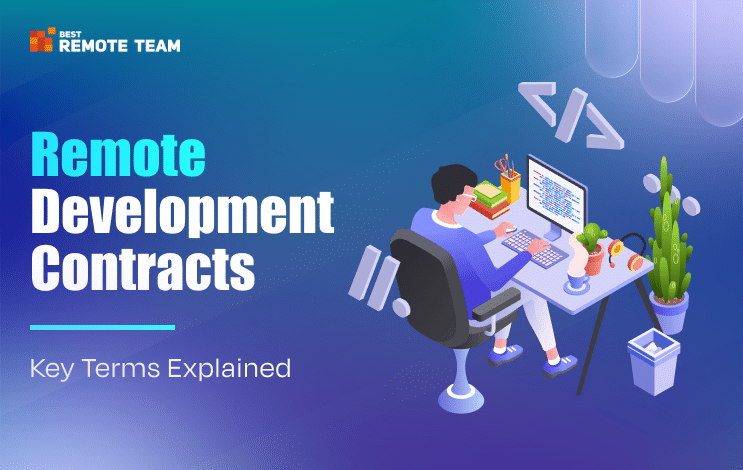What Is a Remote Team Contract and Why Does It Matter?
A remote team contract is a written agreement between a company (the client) and a remote development company or vendor (the service provider).
Basically, it’s a formal document that clearly defines terms and other expectations, like what work needs to be done, hours of working, process, workflows, how it will be delivered, payment terms, timelines and other responsibilities of both sides.
These remote team contracts are very important, especially when working with multi-region or different country clients, because this avoids confusion and helps the remote team to work with mutual agreement and fulfill expectations with productivity.
For large-scale, multi-region, or long-term projects, contracts are essential to:
- Ensure legal and operational alignment between client and vendor.
- Set clear expectations for project delivery.
- Prevent misunderstandings that could impact budget, timeline or quality.
Types of Remote Engagement Models Used by Enterprise IT Teams
Every remote project works differently. With the right engagement model, you can achieve predictable results and get a clear idea about timelines, costs and keep your expectations on track.
#1. Retainer Agreements
A retainer agreement is like hiring a remote team on a monthly or long-term basis.
You pay a fixed fee every month for a suitable number of hours or services.
This model is best if your project requires continuous updates, support or requires new feature development.
With the retainer model, you will always have a dedicated expert to run your project consistently and make changes whenever you want.
#2. Milestone-Based Contracts
Here the project is divided into smaller, clearly defined phases or goals and you need to pay when a specific milestone is completed.
Rather than a fixed price or charging hourly, payment is made when a specific milestone or goal is achieved.
Overall, it’s great for projects with specific deliverables or outcomes.
For example, developing an app module or adding a new feature, where you can check progress step by step.
#3. Time & Material (T&M)
The Time & Material model is used when the project scope is not fully defined at the start or when there is a possibility of changing project requirements.
Here, payment is made according to the resources and time used.
This approach is flexible and can be adjusted according to new updates.
#4. Fixed Bid
A fixed-bid contract means both the client and the developer agree on what needs to be done, how long it will take, and the total cost before starting the work.
The vendor has to complete the entire project at the decided price.
This is best for small or clearly defined projects where the project requirement is fixed.
What Is a Scope of Work (SOW) and Why It’s the Contract Backbone?
A Scope of Work (SOW) is a detailed document that clearly explains what work will be done, who will do it, and how it will be completed.
This is why it’s called a contract backbone because it includes project goals, deliverables, timelines, milestones, payment terms and responsibilities.
A well-written SOW is directly related to your product roadmap and delivery goals.
It helps the remote team understand how the entire project execution is going to be from design to final deployment.
These are the signs of poorly written SOWs; make sure you avoid them.
- Unclear goals and expectations, and not knowing what you are trying to achieve through the project.
- outputs or milestones are not listed.
- No specific deadlines or phase-wise schedules.
- Undefined roles and responsibilities and not clear of who is responsible for what.
- No clear metrics or quality standards to track progress and performance.
- Poor management of approvals and payments.
- Missing details on how and when payments will be made.
- Poor coordination and change management process.
Retainers vs Milestones: Which Is Right for Your Enterprise?
When you work with remote teams, the most confusing question is how to pay, either monthly or after task completion.
The answer depends on how your project grows and how flexible you want to be.
Read below to know which engagement model you should choose based on your project requirements, budget and flexibility.
When to Use the Retainer Engagement Model?
- If you are handling ongoing or long-term projects.
- When you want a dedicated remote team available every month.
- When you want to access multiple skills without hiring multiple vendors.
- Best for scaling teams, adding new features, or post-launch support.
- If you are fine with less flexibility and are able to handle workload changes.
Pros
- You get a dedicated team working for you every month.
- Stable cost so you can easily plan your monthly budget.
- Faster response time as the team is always available.
- You can easily onboard long-term projects.
Cons
- You might need to pay for unused hours if the workload is low.
- Less flexibility if project priorities change suddenly.
- Not great for short-term or one-time projects.
When to Use a Milestones-Based Engagement Model?
- If you are clear about your project and want to execute it phase-wise.
- Best for funded projects where payments are based on deliverables.
- Encourages accountability and transparency through step-by-step approvals.
- If you want to monitor progress and manage quality at each stage.
Pros
- You pay only after each phase or goal is completed.
- Boosts accountability and transparency from both sides.
- You can easily track progress and get an idea of results at each step.
- Great for phased or version-based projects.
Cons
- Needs clear goals and detailed planning from the start.
- It can cause delays if milestones are not approved on time.
- Getting frequent reviews might slow progress.
| Model | Best For | Payment Style | Flexibility | Ideal For |
| Retainer | Ongoing work, support | Monthly fixed fee | Medium | Long-term collaboration |
| Milestone | Goal-based projects | Per milestone | High | Phased delivery |
| Fixed Bid | Short, defined projects | One-time agreed cost | Low | Small, clear-scope projects |
| Time & Material (T&M) | Evolving requirements | Hourly/daily billing | Very high | Research or iterative projects |
How Milestone Contracts Help in Risk Management?
Managing risks is crucial for any IT project to avoid delays, errors, and extra costs.
When you are already sure about your requirements and execute everything one by one, the chances of risks are reduced.
#1. Tracking Progress Through Pre-Defined Phases
In the milestone model, both the client and developers can see the progress, changes and completed modules.
Hence, there is less confusion. Plus, you can easily catch errors or other issues as each phase is thoroughly checked by both parties.
#2. Budget Control Through Deliverable-Based Payments
With fixed requirements and fixed payment, you can properly control your budget as the price for specific task completion is already decided.
It also reduces financial risk, so in case if work doesn’t meet expectations, payments can be paused until issues are fixed.
#3. Transparency In Expectations And Dependencies
Each milestone clearly lists what needs to be delivered, who is responsible and what other tasks depend on it.
When everyone knows what’s expected at each phase, you can collaborate in a more organized way.
For example:
If you want to divide a 6-month project into milestones so you can simply do:
- Month 1 to 2: Research, planning, and wireframes
- Month 3 to 4: Core development and testing
- Month 5: Beta release and feedback
- Month 6: Final delivery and launch
And hence, you can easily charge when one milestone gets completed fully and gets approved by the client.
Legal and Financial Clauses IT Leaders Should Insist On
If you are working with remote teams. As an IT leader, it’s your very first responsibility to check every legal and financial clause before you submit contract requirements.
#1. Intellectual Property And Data Protection
To make sure the company’s sensitive details are protected and only accessed by the authorized team, clearly define who owns the code designs or ideas.
Set rules for handling sensitive data to prevent leaks or misuse.
#2. Payment Terms, Dispute Resolution and SLAs
This is the most important thing to discuss before signing the project deal.
Specify how and when payments will be.
Include Service Level Agreements (SLAs) for expected performance.
Add a dispute resolution clause to solve conflicts if any.
#3. Exit Strategies and Resource Transition Clauses
Plan how the team or resources will hand over after project completion.
Discuss exit strategies, smooth knowledge transfer and continuity of operations.
How to Review and Negotiate a Remote Development Contract?
Negotiating before you start remote development can save a lot of time and money in the long run, especially if you want long-term results.
Follow this checklist while you review the SOW to negotiate fairly.
#1. Define Clear Ownership of Code and Documentation
It’s important to clearly mention who owns the code, designs and documents to avoid disputes later.
Hence, both the client and the remote team must agree on intellectual property rights so that all work produced is legally recognized and protected for future use.
#2. Set Realistic Delivery Schedules and Go-Live Milestones
The deadline given without proper research and unclear requirements lead to late delivery.
Agree only on the achievable timelines and project milestones that are actually possible to do within a specific time limit.
#3. Have An Alignment on Tools, Communication and Timezone
Clarify which tools will be used for project management, code sharing and communication.
Plus also talk about working hours or overlapping time zones for smooth collaboration.
#4. Confirm Support and Maintenance Provisions
Clarify if the remote team will provide post-launch support or updates and for how long.
Plus, also ask what type of support is included in that.
#5. Include Clauses for Adding or Removing Team Members
If, due to any circumstances, any team members need to leave the project in between, check how new developers can join or leave the project without affecting timelines or quality.
Sample SOW Document
| Section | Description | Key Points |
| Project Overview | Brief description of the product/project | Purpose, business goals |
| Deliverables | List of items/services to be delivered | Features, documentation, integrations |
| Roles & Responsibilities | Who does what | Client, vendor, QA, DevOps, PM |
| Timeline & Milestones | Dates and phases | MVP, version releases, QA, deployment |
| Acceptance Criteria | How deliverables are validated | QA testing, sign-offs, feedback loops |
| Payment Terms | Payment linked to milestones or retainer | Amounts, due dates, invoicing |
| IP & Confidentiality | Ownership and data protection | NDA, source code rights |
| Change Management | How scope changes are handled | T&M clauses, addendums |
| Exit & Transition | Steps if contract ends | Handover of code, documentation, knowledge transfer |
Retainer vs Milestone Contract Comparison
| Feature | Retainer | Milestone |
| Payment Model | Fixed monthly fee for team/time access | Payment tied to deliverables |
| Best For | Ongoing support, continuous delivery | MVP, phased releases |
| Flexibility | Moderate | Low–Medium (depends on SOW) |
| Risk | Low delivery risk, cost may fluctuate | Risk of missed deadlines if phases unclear |
| Tracking | Hours or team availability | Completion of defined tasks/milestones |
| Transparency | Moderate | High (linked to outputs) |
| Scalability | Easy to scale team size | Limited to project scope unless renegotiated |
Contract Review Checklist
- Clear ownership of code and documentation
- Realistic delivery schedules and milestones
- Defined communication tools and timezones
- Support & maintenance provisions included
- Flexibility for adding/removing team members
- Well-defined intellectual property & data protection clauses
- Payment terms aligned with milestones or retainer
- Dispute resolution and SLA terms included
- Exit & transition plan for smooth handover
- SOW aligns with overall product roadmap and goals
What Best Remote Team Recommend for Contract Models?
With 14 years of experience and been working with a diverse client base, our Best Remote Team experts suggest starting with the milestone-based approach for MVP to develop a first phase of the project.
This helps to make sure deliverables are completed on time and progress is measurable.
Once the MVP shows positive results and your business expands, you can flexibly move to a retainer-based model with long-term maintenance, updates and scale the team accordingly.
Make sure to have a written Scope of Work (SOW) for every phase to keep the remote team accountable by clearly defining responsibilities, deadlines and expectations.
Case Example: Scaling a SaaS Platform via Milestone-to-Retainer Contract
Here is an example of a case study of how we helped one Saas platform through our approach.
A SaaS company approached us with a tight deadline to launch their product.
Keeping all requirements in mind, we suggested first to go with a 3-month milestone-based contract.
We implemented key features, tested modules and followed a systematic workflow.
As the client noticed clear results and faster deliveries, the client moved to a 12-month retainer for ongoing updates, scaling and maintenance.
With organized phases, continuous support and clear communication channels, we were able to launch the product before the deadline.
Overall, this helped the client to launch their product earlier than the competitor and secure a unique place with better ROI.
Why Best Remote Team is a Trusted Partner for Contracted Development?
With 14 plus years of expertise, we are the choice of leading businesses when it comes to hiring the best remote development company.
We offer skilled developers for all major technologies through flexible contracts that are clear and transparent.
We believe long-term collaborations begin with trust.
This is why we offer custom scopes, legal advice and use compliance frameworks to ensure smooth, secure collaboration for every technology stack.
Many of our clients in North America, Europe and Oceania trust us for long-term retainer partnerships.
Having experienced working with international projects, we assist you with the best strategies and invest in IP protection from day one to prevent legal risks to align perfectly with your expected goals.
Choose us as your outsourcing partner if you need to hire remote developers.
We can help you build reliable development teams with compliance contracts to match your business goals.
Conclusion
Successful remote development begins with the right contract model.
It’s important that you have structured contracts and clear SOWs in writing to be aware of all the milestones, project details, payment terms and working style.
This avoids a lot of confusion and helps to work with mutual understanding with remote developers, no matter what the culture or location is.
Hope by reading the above blog, you must have got much clarity on different contract models like retainer, milestone or SOW to make the best choice based on your business needs.
If you’re new to managing remote teams or are not sure of which contract model fits your project, Best Remote Team can help.
Schedule a free consultation with us to explore remote developers’ options and know more about our outsourcing engagement models.




